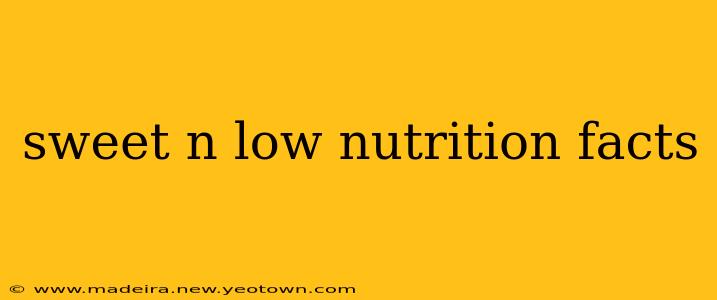Sweet'N Low, a household name for decades, has been a staple for those seeking a lower-calorie alternative to sugar. But what exactly is in this pink packet, and how does its nutritional profile stack up? Let's delve into the sweet details.
The story of Sweet'N Low begins with cyclamate and saccharin, a potent combination that offered a significantly sweeter taste compared to sugar, with fewer calories. But as with many artificial sweeteners, concerns arose over potential health impacts. This led to a journey of reformulation and a deeper understanding of the complexities of artificial sweeteners and their role in our diets.
What's in a Packet of Sweet'N Low?
Sweet'N Low primarily contains saccharin, a non-nutritive sweetener. This means it provides minimal to no calories and doesn't contribute to blood sugar spikes. The specific ingredients and amounts can vary slightly depending on the formulation, but you'll generally find:
- Saccharin: The primary sweetening agent.
- Dextrose: A type of sugar, though present in very small amounts, primarily acting as a bulking agent and to enhance the sweetness profile.
- Other ingredients: These can include fillers and anti-caking agents to ensure the powder flows freely and doesn't clump. These ingredients are typically present in minimal quantities.
How Many Calories are in Sweet'N Low?
This is where Sweet'N Low truly shines. A packet typically contains less than 5 calories, primarily from the trace amounts of dextrose. This dramatically contrasts with sugar, where a teaspoon can provide approximately 15-20 calories. For those watching their calorie intake, this difference can be significant over time.
Is Sweet'N Low Safe?
The safety of saccharin, the main component of Sweet'N Low, has been a subject of ongoing debate and research. While initial concerns led to bans in some countries, later studies have shown that it's generally considered safe for consumption within acceptable daily intake limits. Regulatory bodies worldwide constantly monitor and review the evidence. It's always advisable to consult with your doctor or healthcare professional if you have specific concerns about your dietary choices or underlying health conditions.
What are the potential side effects of Sweet'N Low?
Some individuals report experiencing a slightly bitter aftertaste with saccharin, though tolerance tends to develop with continued use. Others might experience gastrointestinal discomfort like bloating or nausea, though this is less common. It is extremely rare to experience any serious side effects.
Are there alternatives to Sweet'N Low?
Yes, many alternatives exist on the market, each with its own nutritional profile and characteristics. Aspartame (Equal, NutraSweet), sucralose (Splenda), stevia, and monk fruit are among the more popular alternatives. The best choice depends on individual preferences and dietary needs.
Can I use Sweet'N Low in baking?
While Sweet'N Low can be used in baking, it's important to note that it doesn't brown like sugar and may require adjustments to recipes to compensate for its different properties. It's often best to experiment to find the optimal substitution ratios.
How does Sweet'N Low compare to sugar?
The most significant difference lies in the caloric content. Sweet'N Low provides negligible calories compared to the substantial caloric content of sugar. This makes it a suitable choice for those managing weight or blood sugar levels. However, it is crucial to remember that reducing sugar intake through artificial sweeteners is not a replacement for maintaining a balanced, healthy diet and lifestyle.
Sweet'N Low's story exemplifies the ever-evolving landscape of food science and the quest for healthier, lower-calorie options. While individual responses can vary, it remains a popular choice for many who appreciate its sweetness without the hefty caloric burden. Always remember to consult with a healthcare professional for personalized dietary advice.

